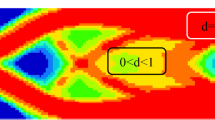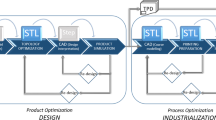Abstract
Additive manufacturing (AM) processes enable the production of functional parts with complex geometries, multi-materials, as well as individualized mass production. Another significant benefit of AM is the ability to produce optimized geometries with near perfect strength to weight ratios. Weight plays a crucial role in many functional parts such as parts used in automotive and aeronautic industries. Current topology optimization techniques, a powerful tool for weight reduction and product optimization in general, do not work well for such kind of process since AM methods necessitate applying own dedicated design rules. This paper reports a product/process optimization study of a simple test case geometry (C-Clip), where structural optimization has been applied using an innovative approach based on the design of lattice structure feasible thanks to additive process adoption. Moreover, it has been conducted a study to evaluate the possible advantages offered by the integration of the two previous approaches in order to verify the required design specifications. The aim of the work has been to evaluate the potentiality offered by the integration of the two structural optimization approaches (topological and lattice structures design) to obtain innovative and highly performing structures. This activity represents a necessary step for the definition and the subsequent development of a methodology aimed to the creation of structures obtained with this combined design approach. In order to define an objective evaluation of the component performances, appropriate Key Performance Indicators (KPI) have been developed. An engineering intelligence tool has been used to post process the generated optimization results for the three different approaches. Finally, the first three “best” structural solutions have been manufactured by 3D printing machine, with scaled dimensions, in order to evaluate the printing time considering the geometry complexity for the chosen structural layout in order to have useful feedbacks on Product/Process choices interaction.
Similar content being viewed by others
References
Becker R, Grzesiak A, Henning A (2005) Rethink assembly design. Assem Autom 25:262–266
Almeida HDA, da Silva Bártolo PJ (2010) Virtual topological optimisation of scaffolds for rapid prototyping. Medical Engineering & Physics 32:775–782
Sundararajan VG (2010) Topology optimization for additive manufacturing of customized meso-structures using homogenization and parametric smoothing functions, Master of Science in Engineering, Texas at Austin
Rezaie R, Badrossamay M, Ghaie A, Moosavi H (2013) Topology optimization for fused deposition modeling process. Procedia CIRP 6:521–526
Chen Y (2007) 3D texture mapping for rapid manufacturing. Computer-Aided Design & Applications 4:761–771
Boothroyd G and Marinwscu I (2002) Product design for manufacture and assembly Marcel Dekker
Godazandeha E, Badrossamay M, Rezaei R, and Tavoosi M (2011) Evaluating fabrication of rapid manufacturing textiles by applying CAD/CAE/AM, presented at the 3rd International Conference on Manufacturing Engineering ICME2011, Iran, Tehran
Zhai Y, Lados DA, LaGoy JL (2014) Additive manufacturing: making imagination the major limitation. JOM 66(5):808–816
Hopkinson N, Hague R, Dickens P (ed) (2006) Rapid manufacturing: an industrial revolution for the digital age. John Wiley & Sons
Bendsoe M, Sigmund O (2003) Topology optimization: theory, methods and applications. Springer, 370 pages
Bendsoe M (1995) Optimization of structural topology, shape and material. Springer
Seepersad CC (2004) A robust topological preliminary design exploration method with materials design applications. Doctoral dissertation. Georgia Institute of Technology
Chang KH, Tang PS (2001) Integration of design and manufacturing for structural shape optimization. Adv Eng Softw 32(7):555–567
Leary M, Merli L, Torti F, Mazur M, Brandt M (2014) Optimal topology for additive manufacture: a method for enabling additive manufacture of support-free optimal structures. Mater Des 63:678–690
Leary M, Babaee M, Brandt M, Subic A (2013) Feasible build orientations for self-supporting fused deposition manufacture: a novel approach to space filling tessellated geometries. Adv Mater Res 633:148–168 Trans Tech Publications, Switzerland
Chahine G, Smith P, Kovacevic R (2010) Application of topology optimization in modern additive manufacturing. In: Solid freeform fabrication symposium, Austin, Texas
Doubrovski Z, Verlinden JC, Geraedts JM (2011) Optimal design for additive manufacturing: opportunities and challenges. In: ASME 2011 international design engineering technical conferences and computers and information in engineering conference. American Society of Mechanical Engineers, p.635–46
Sigmund O (2000) Topology optimization: a tool for the tailoring of structures and materials. Philos Trans R Soc A Math Phys Eng Sci 358(1765):211–227
Jakiela MJ, Chapman C, Duda J, Adewuya A, Saitou K (2000) Continuum structural topology design with genetic algorithms. Comput Methods Appl Mech Eng 186(2):339–356
Pedersen P, Pedersen NL (2006) Reflections on truss and continuum topology optimal designs. In: IUTAM symposium on topological design optimization of structures, machines and materials. Netherlands: Springer, p. 67–76.
Michell AGM (1904) LVIII. The limits of economy of material in frame-structures. London Edinburgh Dublin Philos Mag J Sci 8(47):589–597
Eschenauer HA, Olhoff N (2001) Topology optimization of continuum structures: a review. Appl Mech Rev 54(4):331–390
Bendsoe M, Kikuchi N (1988) Generating optimal topologies in structural design using a homogenization method. Comput Methods Appl Mech Eng 71(2):197–224
Suzuki K, Kikuchi N (1991) A homogenization method for shape and topology optimization. Comput Methods Appl Mech Eng 93(3):291–318
Bendsoe MP (1989) Optimal shape design as a material distribution problem. Struct Optim 1(4):193–202
Zhou M, Rozvany GIN (1991) The COC algorithm, Part II: topological, geometrical and generalized shape optimization. Comput Methods Appl Mech Eng 89(1):309–336
Rozvany GIN (2001) Aims, scope, methods, history and unified terminology of computer-aided topology optimization in structural mechanics. Struct Multidiscipl Optim 21(2):90–108
(2012) Components for rocket engines. In: Ti 2011—Proceedings of the 12th world conference on titanium, vol. 3, Beijing, China, p. 1715–8.
Brandt M, Sun S, Leary M, Feih S, Elambasseril J, Liu Q (2013) High-value SLM aerospace components: from design to manufacture. Adv Mater Res 633:135–147 Trans Tech Publications, Switzerland
Cooper DE, Stanford M, Kibble KA, Gibbons GJ (2012) Additive manufacturing for product improvement at Red Bull Technology. Mater Des 41:226–230
Wohlers T (2012) Additive manufacturing and 3D printing—state of the industry. In: Wohlers Report 2012. Annual worldwide progress report
Gardana N, Schneider A Topological optimization of internal patterns and support in additive manufacturing, Journal of Manufacturing Systems, article in press
HyperWorks User Manual
The Data Warehouse Toolkit, second edition (Wiley), Hoepli, Kimball Ralph, Ross Margy 2003.
Kanellos A (2007) Topological self-organisation: using a particle-spring system simulation to generate structural space-filling lattices University College London
Hanna S, Haroun Mahdavi S Modularity and flexibility at the small scale: evolving continuous material variation with stereolithography ACADIA: New Materials and New Industry.
Author information
Authors and Affiliations
Corresponding author
Rights and permissions
About this article
Cite this article
Primo, T., Calabrese, M., Del Prete, A. et al. Additive manufacturing integration with topology optimization methodology for innovative product design. Int J Adv Manuf Technol 93, 467–479 (2017). https://doi.org/10.1007/s00170-017-0112-9
Received:
Accepted:
Published:
Issue Date:
DOI: https://doi.org/10.1007/s00170-017-0112-9




